Gennaro Cuofano's Blog, page 166
March 10, 2021
Three Simple Negotiation Strategies To Improve Your Negotiation Skills
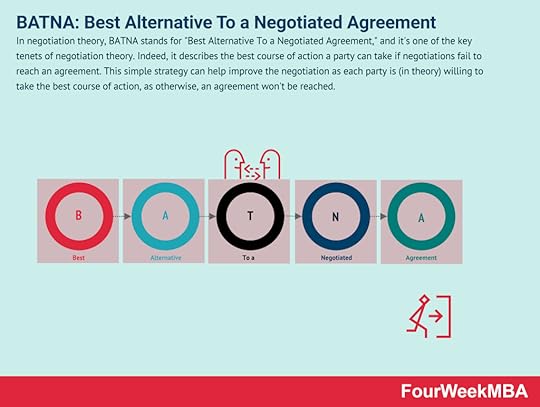 In negotiation theory, BATNA stands for “Best Alternative To a Negotiated Agreement,” and it’s one of the key tenets of negotiation theory. Indeed, it describes the best course of action a party can take if negotiations fail to reach an agreement. This simple strategy can help improve the negotiation as each party is (in theory) willing to take the best course of action, as otherwise, an agreement won’t be reached. WATNA
In negotiation theory, BATNA stands for “Best Alternative To a Negotiated Agreement,” and it’s one of the key tenets of negotiation theory. Indeed, it describes the best course of action a party can take if negotiations fail to reach an agreement. This simple strategy can help improve the negotiation as each party is (in theory) willing to take the best course of action, as otherwise, an agreement won’t be reached. WATNA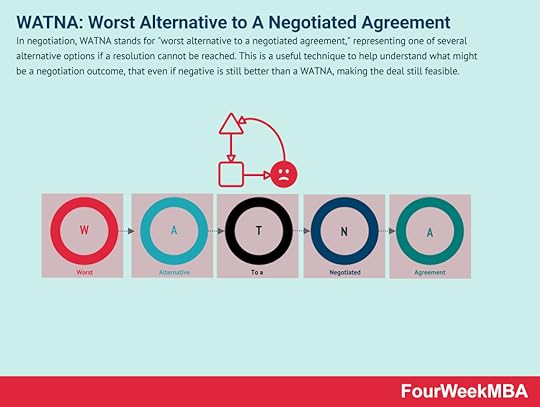 In negotiation, WATNA stands for “worst alternative to a negotiated agreement,” representing one of several alternative options if a resolution cannot be reached. This is a useful technique to help understand what might be a negotiation outcome, that even if negative is still better than a WATNA, making the deal still feasible. ZOPA
In negotiation, WATNA stands for “worst alternative to a negotiated agreement,” representing one of several alternative options if a resolution cannot be reached. This is a useful technique to help understand what might be a negotiation outcome, that even if negative is still better than a WATNA, making the deal still feasible. ZOPA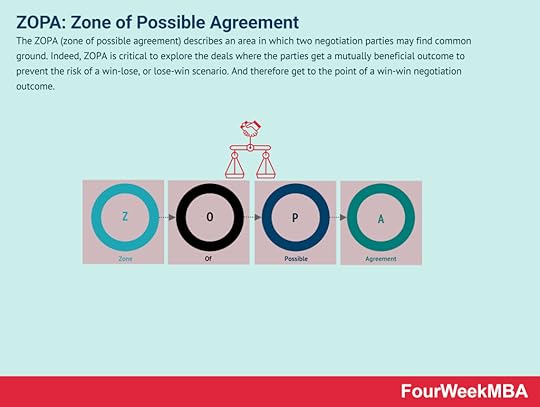 The ZOPA (zone of possible agreement) describes an area in which two negotiation parties may find common ground. Indeed, ZOPA is critical to explore the deals where the parties get a mutually beneficial outcome to prevent the risk of a win-lose, or lose-win scenario. And therefore get to the point of a win-win negotiation outcome.
The ZOPA (zone of possible agreement) describes an area in which two negotiation parties may find common ground. Indeed, ZOPA is critical to explore the deals where the parties get a mutually beneficial outcome to prevent the risk of a win-lose, or lose-win scenario. And therefore get to the point of a win-win negotiation outcome. Read Next: BATNA, WATNA, ZOPA.
Main Free Guides:
Business ModelsBusiness StrategyBusiness DevelopmentDigital Business ModelsDistribution ChannelsMarketing StrategyPlatform Business ModelsTech Business ModelWhat Is EntrepreneurshipThe post Three Simple Negotiation Strategies To Improve Your Negotiation Skills appeared first on FourWeekMBA.
WATNA: Worst Alternative to A Negotiated Agreement
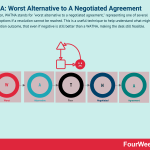
In negotiation, WATNA stands for “worst alternative to a negotiated agreement,” representing one of several alternative options if a resolution cannot be reached. This is a useful technique to help understand what might be a negotiation outcome, that even if negative is still better than a WATNA, making the deal still feasible.
Understanding a WATNAWATNA is an acronym for the “worst alternative to a negotiated agreement”. It describes the worst result a party could achieve if the negotiation process failed.
The WATNA is an important part of the negotiation process. In a book describing the principles of negotiation, authors Matthew P. Guasco and Peter R. Robinson note that “sometimes, the deal on the table is acceptable because it is less bad than your WATNA, i.e., you are minimizing loss or making the best of a bad situation.”
Put differently, the WATNA provides a benchmark that settlement offers can be evaluated against. It gives one party the confidence to accept an outcome that is far from ideal but, relatively speaking, is not the worst possible outcome.
Preparing a WATNA for use in a negotiationBefore a WATNA is prepared, each party must decide how likely that particular outcome will be.
Both parties need to be realistic. If either could achieve their ideal outcome with a minimum of fuss, there would be no need for negotiation in the first place. An organization without a clear WATNA (or BATNA) will enter a negotiation with false and unrealistic expectations.
The worst alternative to a negotiated agreement imbues each party with a sense of purpose at the negotiating table. With greater awareness of their respective worst-case scenario, each party gains more clarity as a result.
When is a WATNA most effective?Sometimes, one party will be forced to cut its losses during a negotiation. This usually occurs in scenarios involving a high degree of uncertainty.
For instance, an unemployed person in discussions with a hiring manager is entering the negotiation in a weak position. The WATNA of the unemployed person may involve being overlooked for the job and having to declare bankruptcy.
However, we noted in the previous section that a WATNA could be used to give a negotiating party more purpose. In this example, purpose means the unemployed individual strengthens their position to reduce uncertainty.
Perhaps the individual applies for as many job as possible and receives a bunch of offers. Armed with a list of comparable jobs, they then become better equipped to use new insights as a negotiation tool during the next job interview.
With greater purpose, the job seeker is in a far stronger position. Instead of bankruptcy, the WATNA becomes successful employment in a low-paid job. While this is a long way from the most desirable outcome, the individual has nevertheless used a WATNA to strengthen their position. As Guasco and Robinson noted, the deal on the table is simply less bad than the original WATNA.
At some point in the future, the position of the person who is now employed may become strong enough to be designated as their BATNA.
Key takeaways:A WATNA describes the worst-case scenario for either party if the negotiation fails completely.A WATNA gives the individual or business the confidence to accept an outcome that, while far from ideal, is better than the worst possible outcome.A WATNA is most effective in negotiations with a high degree of uncertainty. It can encourage a concerned party to cut its losses and move forward with purpose.Read Next: SWOT Analysis, Personal SWOT Analysis, TOWS Matrix, PESTEL Analysis, Porter’s Five Forces.
Main Free Guides:
Business ModelsBusiness StrategyBusiness DevelopmentDigital Business ModelsDistribution ChannelsMarketing StrategyPlatform Business ModelsTech Business ModelWhat Is EntrepreneurshipThe post WATNA: Worst Alternative to A Negotiated Agreement appeared first on FourWeekMBA.
ZOPA: Zone of Possible Agreement
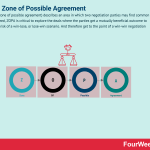
The ZOPA (zone of possible agreement) describes an area in which two negotiation parties may find common ground. Indeed, ZOPA is critical to explore the deals where the parties get a mutually beneficial outcome to prevent the risk of a win-lose, or lose-win scenario. And therefore get to the point of a win-win negotiation outcome.
Understanding the ZOPAIn a typical business negotiation, two polar-opposite errors are commonplace:
The first error is often referred to as an “agreement trap”. This describes a tendency for either party to agree to a deal that is inferior to their BATNA, or their best alternative to a negotiated agreement.
The second error occurs when both organizations walk away from a mutually beneficial outcome. In this case, negotiators fail to compromise on certain issues to obtain a satisfactory deal.
Avoiding these unfortunate circumstances can be achieved by the identification of a ZOPA – or zone of possible agreement. This zone encompasses a range where deals are made that both parties find acceptable.
Foundational elements of the ZOPAThe ZOPA can only be properly understood by each party determining its respective:
BATNA, or the best course of action it can pursue if no agreement is reached.Bottom line, or “walk-away” position. If an agreement cannot be reached that satisfies the bottom line, then the party in question exits the negotiation.The ZOPA can only exist if there is an overlap between the walk-away positions of each party. Otherwise, negotiations are likely to fail.
The ZOPA in negotiationIn theory, parties entering a negotiation with a BATNA and walk-away position should be able to successfully reach an agreement. When a negotiator learns the bottom line of the opposing party, they can quickly determine the ZOPA and use collaborative techniques to close the deal.
However, the negotiation is often stymied when one party fails to properly define its BATNA or has no awareness of the other side’s BATNA.
This leads to varying degrees of posturing. Since better alternatives are equated with higher bargaining power, some exaggerate or fabricate their position to get what they want. However, the result of this posturing is a failure to identify the ZOPA and come to an amicable agreement.
It’s important to remember that in most negotiations, a ZOPA does exist. But uncertainty around the value of alternatives causes both parties to be unrealistically optimistic or pessimistic about finding it.
The ZOPA in integrative or distributive negotiationsIntegrative negotiations
Integrative negotiations involve the creation of value, otherwise known as “enlarging the pie”.
This occurs when both parties have shared interests and can make trade-offs on certain issues to create mutual value. Here, the ZOPA allows both parties to “win” by walking away with a different piece of the same pie – even if neither walks away with everything they originally wanted.
Distributive (competitive) negotiations
While integrative negotiations seek to enlarge the pie, the focus of distributive negotiations is the dividing of a pie of fixed size.
In this scenario, it is much more difficult to find a mutually acceptable solution because both sides want to claim as much of the pie as possible. Unlike an integrative negotiation, there is no ZOPA where interests overlap. It is very much a zero-sum game, where one party must lose so that the other can win.
Ultimately, the only way that distributive negotiations can be successful is by splitting the pie down the middle. Using this ZOPA, each party wins half of what they wanted and loses the other half.
Key takeaways:The ZOPA, or zone of potential agreement, describes a theoretical area where two negotiating parties may find common ground.The ZOPA can only be determined and negotiated upon if both parties understand their BATNA and bottom line.The ZOPA is an integrative negotiation that involves both parties making trade-offs around shared interests. In a somewhat adversarial distributive negotiation, the ZOPA may only be reached by splitting the total value in half.Read Next: SWOT Analysis, Personal SWOT Analysis, TOWS Matrix, PESTEL Analysis, Porter’s Five Forces.
Main Free Guides:
Business ModelsBusiness StrategyBusiness DevelopmentDigital Business ModelsDistribution ChannelsMarketing StrategyPlatform Business ModelsTech Business ModelWhat Is EntrepreneurshipThe post ZOPA: Zone of Possible Agreement appeared first on FourWeekMBA.
BATNA: Best Alternative To a Negotiated Agreement
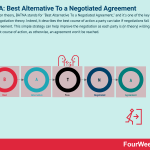
In negotiation theory, BATNA stands for “Best Alternative To a Negotiated Agreement,” and it’s one of the key tenets of negotiation theory. Indeed, it describes the best course of action a party can take if negotiations fail to reach an agreement. This simple strategy can help improve the negotiation as each party is (in theory) willing to take the best course of action, as otherwise, an agreement won’t be reached.
Understanding a BATNABATNA is an acronym for the term “best alternative to a negotiated agreement”.
The term was first coined by Roger Fisher and William Ury in their 1981 book Getting to Yes: Negotiating Without Giving In.
It’s important to understand that the best alternative to a negotiated agreement is not necessarily the ideal outcome. Instead, businesses should consider a BATNA to be the best they can do without the cooperation of the other party.
BATNAs are a critical part of negotiation tactics that should be in place before any business enters into a discussion. This helps decision-makers avoid accepting a worse outcome than they could get elsewhere. A solid BATNA also helps each party avoid rejecting an outcome that is better than its best alternative.
A BATNA can deliver several important other benefits:
It gives the business something to fall back on if negotiations fail.It increases negotiation power. If a good alternative exists, the business does not need to concede as much. As a result, it can push the other party harder for a better deal.It clarifies the reservation point, or the worst outcome the business is willing to accept.Formulating a BATNAA BATNA may not be immediately apparent. However, Fisher and Ury also provided a simple framework for stuck businesses:
Start by brainstorming a list of actions that could be taken in the event an agreement is not reached. At this point, these actions are purely theoretical. But they must be realistic.Refine the list of actions according to their practicality, feasibility, and potential to add value. The definition of value will vary according to the individual business, context, or market it operates in.Tentatively select one option that seems to have the best mix of characteristics.Lastly, formulate the reservation point. Remember that this is the lowest-valued deal the business is willing to accept. BATNA best practices in businessNegotiations are often high-stress environments, so it is crucial to act decisively and strategically to ensure an optimal outcome.
Here are some BATNA best practices:
Do not reveal a weak BATNA, otherwise known as a WATNA (worst alternative to a negotiated agreement). This gives the impression of a business with little leverage that will accept any deal that is put in front of them – regardless of whether it benefits them.Do not bluff about a BATNA. If prompted by the other party, explain that a range of possible alternatives is being assessed. But maintain a focus on the current deal and do not embellish or fabricate a BATNA to increase bargaining power.Do not reveal a BATNA too early. This can be misconstrued as hostility by the other party, creating a tense and non-collaborative atmosphere which stifles negotiation. Even if the business has a robust BATNA, it is better used at the end of the process once all other avenues have been exhausted.Work to actively improve a BATNA with a longer-term view. The business must do everything it can to actively improve an alternative course of action.Avoid being talked out of a BATNA. If the other party criticizes or discourages a BATNA, the business must realize that this is nothing more than a negotiation tactic. In other words, the other party stands to benefit by encouraging you to take a lower-valued course of action. Key takeaways:A BATNA, or the best alternative to a negotiated agreement, is a course of action to be taken when the negotiation process fails. Establishing a BATNA begins with brainstorming a list of theoretical actions and then choosing the one with the highest potential to add value.Best practices dictate how a BATNA should be used. A business should avoid fabricating or exaggerating a BATNA as this could erode the integrity of their position in the negotiation itself.Read Next: SWOT Analysis, Personal SWOT Analysis, TOWS Matrix, PESTEL Analysis, Porter’s Five Forces.
Main Free Guides:
Business ModelsBusiness StrategyBusiness DevelopmentDigital Business ModelsDistribution ChannelsMarketing StrategyPlatform Business ModelsTech Business ModelWhat Is EntrepreneurshipThe post BATNA: Best Alternative To a Negotiated Agreement appeared first on FourWeekMBA.
Crypto Terms
 Blockchain technology is the use of cryptography to link data. It is basically a list of records that is unalterable. Along with this, it is also decentralized meaning it is not in the control of a single entity and is distributed among several entities to divide the power. In order to link the data is linked through a process known as “cryptographic hashing”. It uses a mathematical algorithm to map the data of arbitrary size to a fixed size.Blockchain Business Models
Blockchain technology is the use of cryptography to link data. It is basically a list of records that is unalterable. Along with this, it is also decentralized meaning it is not in the control of a single entity and is distributed among several entities to divide the power. In order to link the data is linked through a process known as “cryptographic hashing”. It uses a mathematical algorithm to map the data of arbitrary size to a fixed size.Blockchain Business Models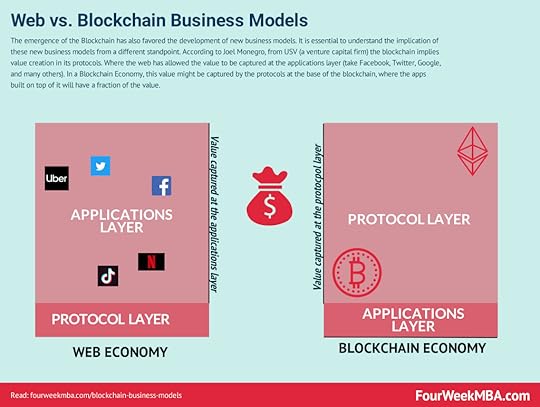 The emergence of the Blockchain has also favored the development of new business models. It is essential to understand the implication of these new business models from a different standpoint. According to Joel Monegro, from USV (a venture capital firm) the blockchain implies value creation in its protocols. Where the web has allowed the value to be captured at the applications layer (take Facebook, Twitter, Google, and many others). In a Blockchain Economy, this value might be captured by the protocols at the base of the blockchain, where the apps built on top of it will have a fraction of the value.Blockchain Economics
The emergence of the Blockchain has also favored the development of new business models. It is essential to understand the implication of these new business models from a different standpoint. According to Joel Monegro, from USV (a venture capital firm) the blockchain implies value creation in its protocols. Where the web has allowed the value to be captured at the applications layer (take Facebook, Twitter, Google, and many others). In a Blockchain Economy, this value might be captured by the protocols at the base of the blockchain, where the apps built on top of it will have a fraction of the value.Blockchain Economics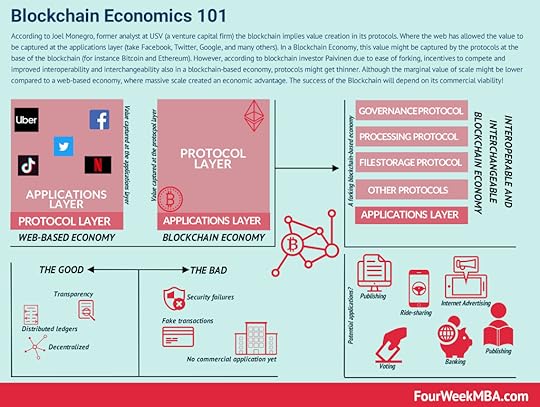 According to Joel Monegro, former analyst at USV (a venture capital firm) the blockchain implies value creation in its protocols. Where the web has allowed the value to be captured at the applications layer (take Facebook, Twitter, Google, and many others). In a Blockchain Economy, this value might be captured by the protocols at the base of the blockchain (for instance Bitcoin and Ethereum). However, according to blockchain investor Paivinen due to ease of forking, incentives to compete and improved interoperability and interchangeability also in a blockchain-based economy, protocols might get thinner. Although the marginal value of scale might be lower compared to a web-based economy, where massive scale created an economic advantage. The success of the Blockchain will depend on its commercial viability!Ethereum Blockchain
According to Joel Monegro, former analyst at USV (a venture capital firm) the blockchain implies value creation in its protocols. Where the web has allowed the value to be captured at the applications layer (take Facebook, Twitter, Google, and many others). In a Blockchain Economy, this value might be captured by the protocols at the base of the blockchain (for instance Bitcoin and Ethereum). However, according to blockchain investor Paivinen due to ease of forking, incentives to compete and improved interoperability and interchangeability also in a blockchain-based economy, protocols might get thinner. Although the marginal value of scale might be lower compared to a web-based economy, where massive scale created an economic advantage. The success of the Blockchain will depend on its commercial viability!Ethereum Blockchain Ethereum is a cryptocurrency currently ranking at number two in market capitalization after Bitcoin, which is at the top. However, in terms of being used actively, Ethereum is ahead of Bitcoin. While Bitcoin is sent, received, and held only in a singular form, Ethereum allows entities to create different ledgers. These can even be used to create additional cryptocurrencies. The use and transactions using Ethereum have grown consistently over the years ever since it began operations half a decade ago.Smart Contracts
Ethereum is a cryptocurrency currently ranking at number two in market capitalization after Bitcoin, which is at the top. However, in terms of being used actively, Ethereum is ahead of Bitcoin. While Bitcoin is sent, received, and held only in a singular form, Ethereum allows entities to create different ledgers. These can even be used to create additional cryptocurrencies. The use and transactions using Ethereum have grown consistently over the years ever since it began operations half a decade ago.Smart Contracts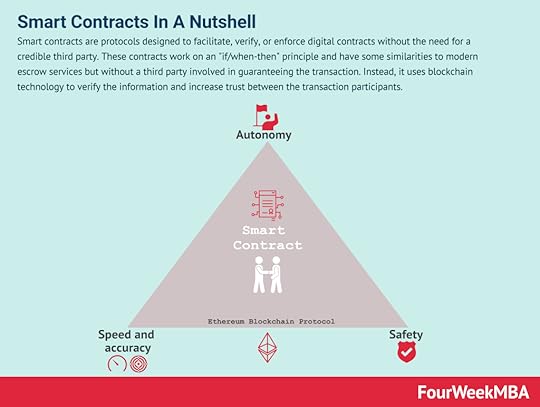 Smart contracts are protocols designed to facilitate, verify, or enforce digital contracts without the need for a credible third party. These contracts work on an “if/when-then” principle and have some similarities to modern escrow services but without a third party involved in guaranteeing the transaction. Instead, it uses blockchain technology to verify the information and increase trust between the transaction participants.Stablecoins
Smart contracts are protocols designed to facilitate, verify, or enforce digital contracts without the need for a credible third party. These contracts work on an “if/when-then” principle and have some similarities to modern escrow services but without a third party involved in guaranteeing the transaction. Instead, it uses blockchain technology to verify the information and increase trust between the transaction participants.Stablecoins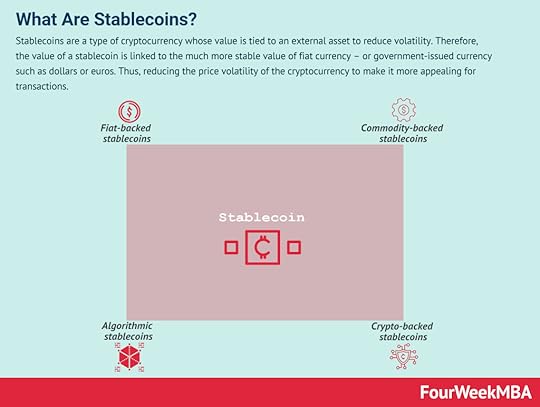 Stablecoins are a type of cryptocurrency whose value is tied to an external asset to reduce volatility. Therefore, the value of a stablecoin is linked to the much more stable value of fiat currency – or government-issued currency such as dollars or euros. Thus, reducing the price volatility of the cryptocurrency to make it more appealing for transactions.Decentralized Finance
Stablecoins are a type of cryptocurrency whose value is tied to an external asset to reduce volatility. Therefore, the value of a stablecoin is linked to the much more stable value of fiat currency – or government-issued currency such as dollars or euros. Thus, reducing the price volatility of the cryptocurrency to make it more appealing for transactions.Decentralized Finance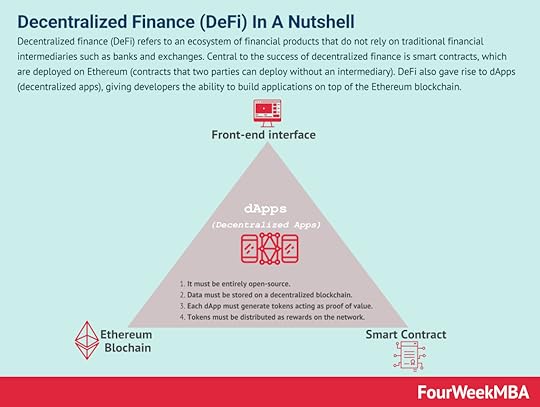 Decentralized finance (DeFi) refers to an ecosystem of financial products that do not rely on traditional financial intermediaries such as banks and exchanges. Central to the success of decentralized finance is smart contracts, which are deployed on Ethereum (contracts that two parties can deploy without an intermediary). DeFi also gave rise to dApps (decentralized apps), giving developers the ability to build applications on top of the Ethereum blockchain.Non-fungible Tokens
Decentralized finance (DeFi) refers to an ecosystem of financial products that do not rely on traditional financial intermediaries such as banks and exchanges. Central to the success of decentralized finance is smart contracts, which are deployed on Ethereum (contracts that two parties can deploy without an intermediary). DeFi also gave rise to dApps (decentralized apps), giving developers the ability to build applications on top of the Ethereum blockchain.Non-fungible Tokens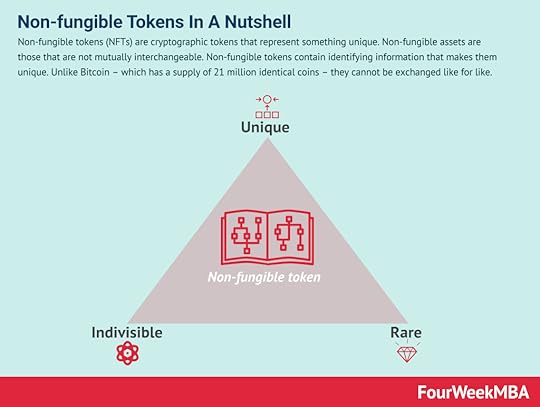 Non-fungible tokens (NFTs) are cryptographic tokens that represent something unique. Non-fungible assets are those that are not mutually interchangeable. Non-fungible tokens contain identifying information that makes them unique. Unlike Bitcoin – which has a supply of 21 million identical coins – they cannot be exchanged like for like.Proof of Work
Non-fungible tokens (NFTs) are cryptographic tokens that represent something unique. Non-fungible assets are those that are not mutually interchangeable. Non-fungible tokens contain identifying information that makes them unique. Unlike Bitcoin – which has a supply of 21 million identical coins – they cannot be exchanged like for like.Proof of Work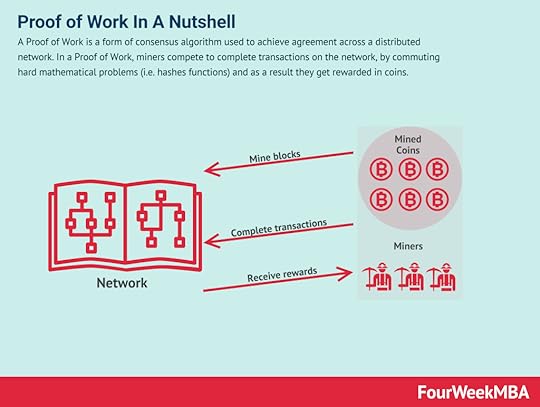 A Proof of Work is a form of consensus algorithm used to achieve agreement across a distributed network. In a Proof of Work, miners compete to complete transactions on the network, by commuting hard mathematical problems (i.e. hashes functions) and as a result they get rewarded in coins.Proof of Stake
A Proof of Work is a form of consensus algorithm used to achieve agreement across a distributed network. In a Proof of Work, miners compete to complete transactions on the network, by commuting hard mathematical problems (i.e. hashes functions) and as a result they get rewarded in coins.Proof of Stake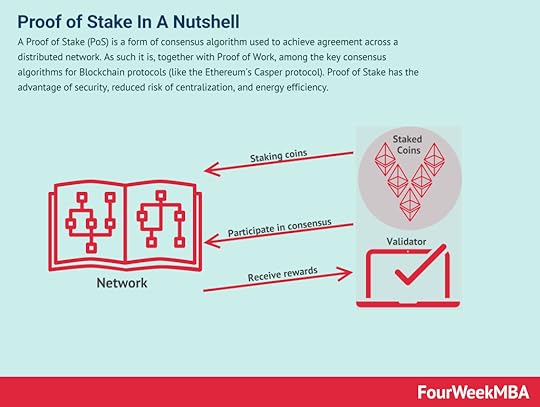 A Proof of Stake (PoS) is a form of consensus algorithm used to achieve agreement across a distributed network. As such it is, together with Proof of Work, among the key consensus algorithms for Blockchain protocols (like the Ethereum’s Casper protocol). Proof of Stake has the advantage of security, reduced risk of centralization, and energy efficiency.Coinbase Business Model
A Proof of Stake (PoS) is a form of consensus algorithm used to achieve agreement across a distributed network. As such it is, together with Proof of Work, among the key consensus algorithms for Blockchain protocols (like the Ethereum’s Casper protocol). Proof of Stake has the advantage of security, reduced risk of centralization, and energy efficiency.Coinbase Business Model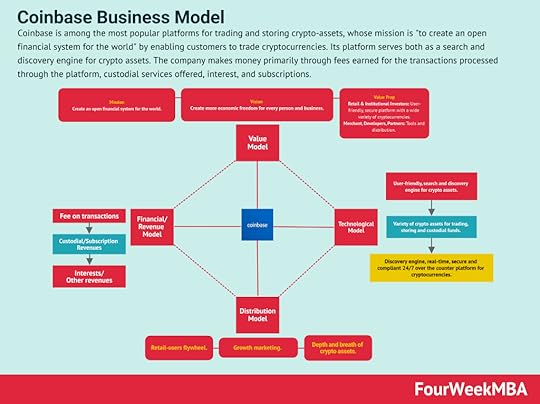 Coinbase is among the most popular platforms for trading and storing crypto-assets, whose mission is “to create an open financial system for the world” by enabling customers to trade cryptocurrencies. Its platform serves both as a search and discovery engine for crypto assets. The company makes money primarily through fees earned for the transactions processed through the platform, custodial services offered, interest, and subscriptions.Steemit Business Model
Coinbase is among the most popular platforms for trading and storing crypto-assets, whose mission is “to create an open financial system for the world” by enabling customers to trade cryptocurrencies. Its platform serves both as a search and discovery engine for crypto assets. The company makes money primarily through fees earned for the transactions processed through the platform, custodial services offered, interest, and subscriptions.Steemit Business Model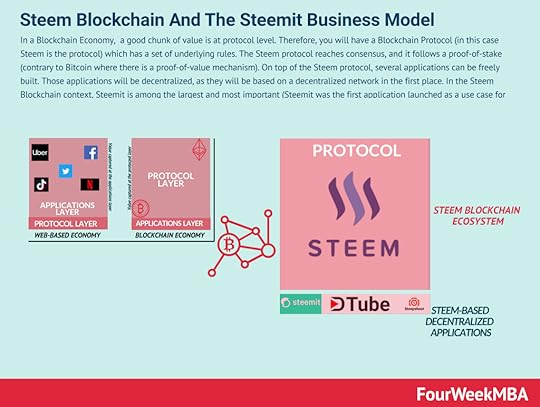 In a Blockchain Economy, a good chunk of value is at protocol level. Therefore, you will have a Blockchain Protocol (in this case Steem is the protocol) which has a set of underlying rules. The Steem protocol reaches consensus, and it follows a proof-of-stake (contrary to Bitcoin where there is a proof-of-value mechanism). On top of the Steem protocol, several applications can be freely built. Those applications will be decentralized, as they will be based on a decentralized network in the first place. In the Steem Blockchain context, Steemit is among the largest and most important (Steemit was the first application launched as a use case for the Steem Protocol).
In a Blockchain Economy, a good chunk of value is at protocol level. Therefore, you will have a Blockchain Protocol (in this case Steem is the protocol) which has a set of underlying rules. The Steem protocol reaches consensus, and it follows a proof-of-stake (contrary to Bitcoin where there is a proof-of-value mechanism). On top of the Steem protocol, several applications can be freely built. Those applications will be decentralized, as they will be based on a decentralized network in the first place. In the Steem Blockchain context, Steemit is among the largest and most important (Steemit was the first application launched as a use case for the Steem Protocol).Main Free Guides:
Business ModelsBusiness StrategyBusiness DevelopmentDigital Business ModelsDistribution ChannelsMarketing StrategyPlatform Business ModelsTech Business ModelWhat Is EntrepreneurshipThe post Crypto Terms appeared first on FourWeekMBA.
March 9, 2021
Competitor Analysis Examples
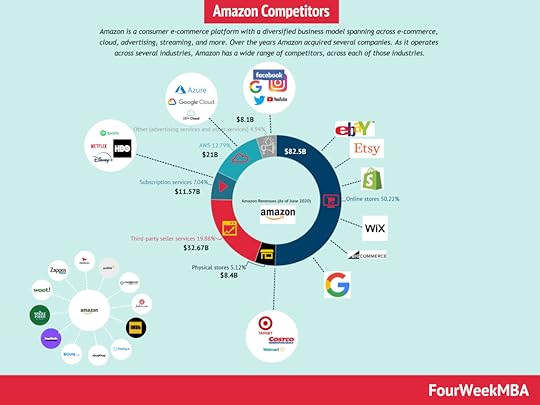 Amazon is a consumer e-commerce platform with a diversified business model spanning across e-commerce, cloud, advertising, streaming, and more. Over the years, Amazon acquired several companies. As it operates across several industries, Amazon has a wide range of competitors across each of those industries. For instance, Amazon E-commerce competes with Shopify, Wix, Google, Etsy, eBay, BigCommerce.
Amazon is a consumer e-commerce platform with a diversified business model spanning across e-commerce, cloud, advertising, streaming, and more. Over the years, Amazon acquired several companies. As it operates across several industries, Amazon has a wide range of competitors across each of those industries. For instance, Amazon E-commerce competes with Shopify, Wix, Google, Etsy, eBay, BigCommerce.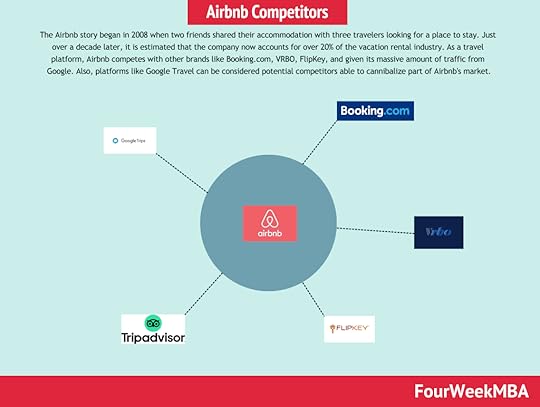 The Airbnb story began in 2008 when two friends shared their accommodation with three travelers looking for a place to stay. Just over a decade later, it is estimated that the company now accounts for over 20% of the vacation rental industry. As a travel platform, Airbnb competes with other brands like Booking.com, VRBO, FlipKey, and given its massive amount of traffic from Google. Also, platforms like Google Travel can be considered potential competitors able to cannibalize part of Airbnb’s market.
The Airbnb story began in 2008 when two friends shared their accommodation with three travelers looking for a place to stay. Just over a decade later, it is estimated that the company now accounts for over 20% of the vacation rental industry. As a travel platform, Airbnb competes with other brands like Booking.com, VRBO, FlipKey, and given its massive amount of traffic from Google. Also, platforms like Google Travel can be considered potential competitors able to cannibalize part of Airbnb’s market.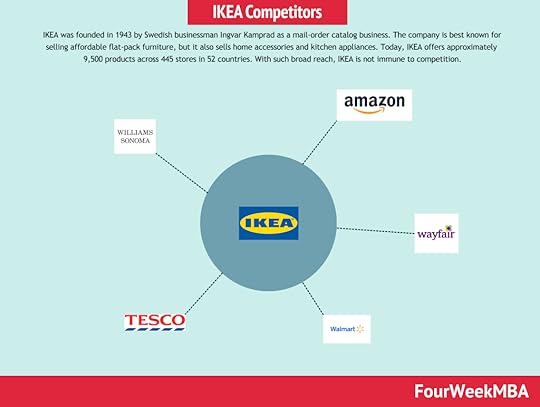 IKEA was founded in 1943 by Swedish businessman Ingvar Kamprad as a mail-order catalog business. The company is best known for selling affordable flat-pack furniture, but it also sells home accessories and kitchen appliances. Today, IKEA offers approximately 9,500 products across 445 stores in 52 countries. With such broad reach, IKEA is not immune to competition.
IKEA was founded in 1943 by Swedish businessman Ingvar Kamprad as a mail-order catalog business. The company is best known for selling affordable flat-pack furniture, but it also sells home accessories and kitchen appliances. Today, IKEA offers approximately 9,500 products across 445 stores in 52 countries. With such broad reach, IKEA is not immune to competition.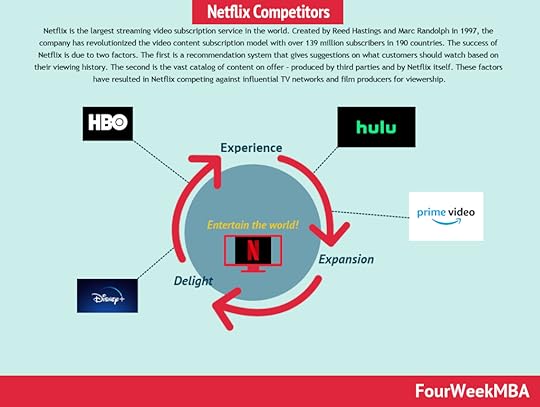 Netflix is the largest streaming video subscription service in the world. Created by Reed Hastings and Marc Randolph in 1997, the company has revolutionized the video content subscription model with over 139 million subscribers in 190 countries. The success of Netflix is due to two factors. The first is a recommendation system that gives suggestions on what customers should watch based on their viewing history. The second is the vast catalog of content on offer – produced by third parties and by Netflix itself. These factors have resulted in Netflix competing against influential TV networks and film producers for viewership.
Netflix is the largest streaming video subscription service in the world. Created by Reed Hastings and Marc Randolph in 1997, the company has revolutionized the video content subscription model with over 139 million subscribers in 190 countries. The success of Netflix is due to two factors. The first is a recommendation system that gives suggestions on what customers should watch based on their viewing history. The second is the vast catalog of content on offer – produced by third parties and by Netflix itself. These factors have resulted in Netflix competing against influential TV networks and film producers for viewership. 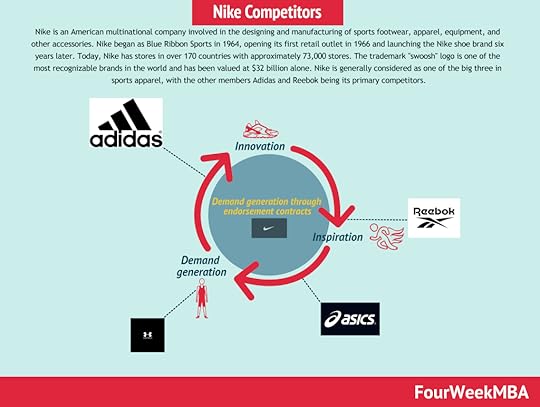
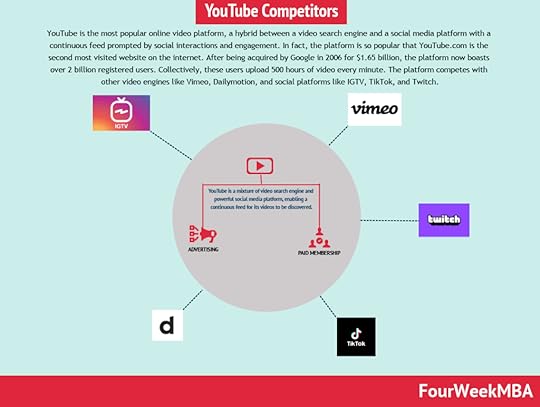 YouTube is the most popular online video platform, a hybrid between a video search engine and a social media platform with a continuous feed prompted by social interactions and engagement. In fact, the platform is so popular that YouTube.com is the second most visited website on the internet. After being acquired by Google in 2006 for $1.65 billion, the platform now boasts over 2 billion registered users. Collectively, these users upload 500 hours of video every minute. The platform competes with other video engines like Vimeo, Dailymotion, and social platforms like IGTV, TikTok, and Twitch.
YouTube is the most popular online video platform, a hybrid between a video search engine and a social media platform with a continuous feed prompted by social interactions and engagement. In fact, the platform is so popular that YouTube.com is the second most visited website on the internet. After being acquired by Google in 2006 for $1.65 billion, the platform now boasts over 2 billion registered users. Collectively, these users upload 500 hours of video every minute. The platform competes with other video engines like Vimeo, Dailymotion, and social platforms like IGTV, TikTok, and Twitch.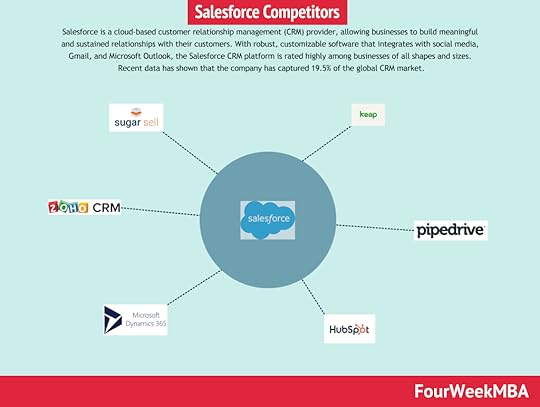 Salesforce is a cloud-based customer relationship management (CRM) provider, allowing businesses to build meaningful and sustained relationships with their customers. With robust, customizable software that integrates with social media, Gmail, and Microsoft Outlook, the Salesforce CRM platform is rated highly among businesses of all shapes and sizes. Recent data has shown that the company has captured 19.5% of the global CRM market.
Salesforce is a cloud-based customer relationship management (CRM) provider, allowing businesses to build meaningful and sustained relationships with their customers. With robust, customizable software that integrates with social media, Gmail, and Microsoft Outlook, the Salesforce CRM platform is rated highly among businesses of all shapes and sizes. Recent data has shown that the company has captured 19.5% of the global CRM market. 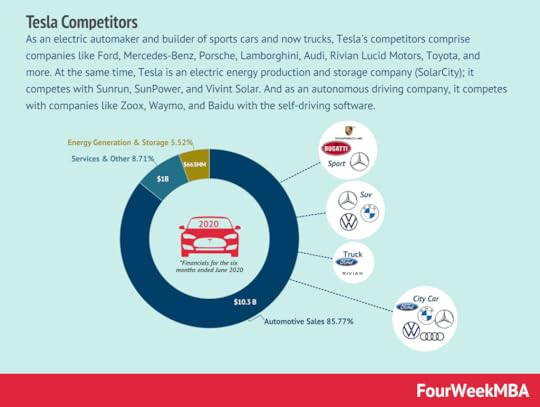 As an electric automaker and builder of sports cars and now trucks, Tesla’s competitors comprise companies like Ford, Mercedes-Benz, Porsche, Lamborghini, Audi, Rivian Lucid Motors, Toyota, and more. At the same time, Tesla is an electric energy production and storage company (SolarCity); it competes with Sunrun, SunPower, and Vivint Solar. And as an autonomous driving company, it competes with companies like Zoox, Waymo, and Baidu with the self-driving software.
As an electric automaker and builder of sports cars and now trucks, Tesla’s competitors comprise companies like Ford, Mercedes-Benz, Porsche, Lamborghini, Audi, Rivian Lucid Motors, Toyota, and more. At the same time, Tesla is an electric energy production and storage company (SolarCity); it competes with Sunrun, SunPower, and Vivint Solar. And as an autonomous driving company, it competes with companies like Zoox, Waymo, and Baidu with the self-driving software. 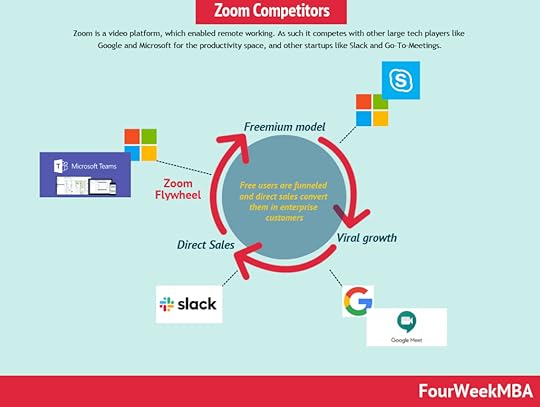 Zoom is a video platform, which enabled remote working. As such it competes with other large tech players like Google and Microsoft for the productivity space, and other startups like Slack and Go-To-Meetings.
Zoom is a video platform, which enabled remote working. As such it competes with other large tech players like Google and Microsoft for the productivity space, and other startups like Slack and Go-To-Meetings.Read Next: Competitor Analysis, Amazon Competitors, Tesla Competitors, Zoom Competitors, YouTube Competitors, Netflix Competitors, Shopify Competitors, Salesforce Competitors, Airbnb Competitors, IKEA Competitors.
Read More:
Business ModelsPlatform Business ModelsDigital Business ModelsDistribution ChannelsBusiness StrategyValue PropositionMarketing StrategyBrand BuildingSWOT AnalysisThe post Competitor Analysis Examples appeared first on FourWeekMBA.
IKEA Competitors
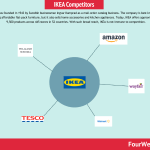
IKEA was founded in 1943 by Swedish businessman Ingvar Kamprad as a mail-order catalog business. The company is best known for selling affordable flat-pack furniture, but it also sells home accessories and kitchen appliances. Today, IKEA offers approximately 9,500 products across 445 stores in 52 countries. With such broad reach, IKEA is not immune to competition.
AmazonAmazon’s recently launched Stone & Beam furniture brand is a serious threat to IKEA. The company offers a wide range of furniture with many products arriving already assembled.
Amazon also offers free shipping on their products which gives the company a significant advantage over IKEA.
WayfairWayfair is the largest online shopping platform for home furnishings, décor, and appliances in the United States.
It offers more than ten million items from over 10,000 suppliers, allowing it to capture 4.4% of the US furniture market. Indeed, a core competitive advantage of Wayfair is the diversity of their product range.
Wayfair, like Amazon, has taken advantage of a general shift to buying furniture online and significantly increased market share.
WalmartWalmart also offers a large range of furniture and home décor that is budget-friendly. This includes in-house brands and a selection of products from other brands.
The company has made a significant investment in its eCommerce offering, Walmart+. The affordability and reach of the retail giant make it a significant player in global furniture sales.
Walmart has a proven track record in gaining a competitive advantage. It does this by reducing production costs, carrying certain costs, and providing bargain-basement prices.
TescoTesco is another supermarket retail giant that is adding an increasing number of furniture products to its range.
Although headquartered in the United Kingdom, Tesco has expanded into other parts of Europe and Asia. It offers a range of homeware products including furniture and other household essentials.
Tesco is generally seen as a company that offers an important mix of high-quality furniture, good customer service, and affordable pricing.
Williams SonomaWilliams Sonoma is a retailer with a long and proud history of selling furniture in the United States.
For over 60 years, the company has been selling home furniture and cookware in over 650 stores. The company has also expanded beyond the United States, selling furniture in 60 countries under brand names such as Pottery Barn.
Williams Sonoma has become so successful that it was included on the Fortune 500 list in 2019.
Ashley Furniture HomeStoreAshley Furniture HomeStore is a relatively new competitor to IKEA, having only been founded in 1997.
However, the company has quickly risen to be a market leader for furniture revenue in the United States.
Importantly, Ashley Furniture HomeStore is both an owner of furniture stores and a manufacturer of furniture products. With more control over manufacturing and distribution, the company may become a serious global threat if it can replicate its success outside of North America.
Key takeaways:IKEA operates 445 stores in 52 countries offering 9,500 products. Its diverse product range and broad geographical reach puts it up against a range of worthy competitors.Tesco and Walmart are two IKEA competitors that use economies of scale derived from their respective supermarket divisions to reduce costs.In the lucrative North American market, Wayfair and Williams Sonoma are powerful, established brands.Read Also: IKEA Business Model, Amazon Business Model, Walmart Business Model.
Read Next: Competitor Analysis, Amazon Competitors, Tesla Competitors, Zoom Competitors, YouTube Competitors, Netflix Competitors, Shopify Competitors, Salesforce Competitors, Airbnb Competitors.
Main Free Guides:
Business ModelsBusiness StrategyBusiness DevelopmentDigital Business ModelsDistribution ChannelsMarketing StrategyPlatform Business ModelsTech Business ModelWhat Is EntrepreneurshipThe post IKEA Competitors appeared first on FourWeekMBA.
Airbnb Competitors

The Airbnb story began in 2008 when two friends shared their accommodation with three travelers looking for a place to stay. Just over a decade later, it is estimated that the company now accounts for over 20% of the vacation rental industry. As a travel platform, Airbnb competes with other brands like Booking.com, VRBO, FlipKey, and given its massive amount of traffic from Google. Also, platforms like Google Travel can be considered potential competitors able to cannibalize part of Airbnb’s market.
Booking.comMany think of Booking.com as an online hotel aggregator, but the company also lists over 6 million private homes and apartments.
This means that vacation rental listings compete directly with hotel vacancies during a search. As a result, it is thought that holiday makers searching for hotel accommodation may then change their mind after being exposed to private listings.
To increase conversions, Booking.com also offers a range of tools to private property owners. In some cases, the Booking.com commission fee is much lower than a comparable Airbnb fee.
VRBOVRBO is a veteran of the vacation rental industry, having been founded in 1995.
Owned by the Expedia Group, property owners who use VRBO tap into approximately 730 million monthly users who visit the Expedia global family of sites.
While VRBO matches Airbnb in terms of diversity of property type, it cannot compete with the sheer number of properties that Airbnb lists. Having said that, VRBO tends to be geared to more affluent users or families who require larger homes.
Like Airbnb, VRBO users can earn titles by maintaining high average ratings and low cancellation rates. Commission fees between the two companies are also quite similar.
FlipKeyA key competitor of Airbnb, FlipKey is an online marketplace listing more than 830,000 properties in 190 countries.
FlipKey allows owners to list their properties for free and gives users the ability to search for properties using a variety of parameters. The company also offers a group booking facility in most of the world’s popular tourist destinations.
The fee structure is the most defining characteristic of FlipKey, charging a 3% processing fee and a subsequent fee of 5 to 15% of the total rental cost.
GoogleIn recent years, search engine company Google has been exerting its influence in the vacation rental market.
In partnership with certain online travel agencies and channel managers, Google now incorporates vacation listings into Google Maps and travel-related search results.
Google represents a major competitor to Airbnb – at least where organic search is concerned. Vacation rentals listed through one of the search engine’s trusted partners are likely to occupy a high visibility position and be seen by millions of searchers.
TripAdvisorTripAdvisor (TA) is the largest review site on the internet with almost half a billion monthly users.
Like Booking.com, TA is an online travel agency as opposed to a rental marketplace. Nevertheless, it offers hotel accommodation alongside vacation rentals and other services such as car hire.
TripAdvisor can also be read in 26 languages, so it could be argued that TA has far more reach than Airbnb. To further increase its reach, TA owns a suite of related sites such as FlipKey and Holiday Lettings.
Key takeaways:Airbnb has cornered 20% of the vacation rental industry, but it faces high competition from companies offering low commissions for property owners.Traditional hotel booking companies such as Booking.com and TripAdvisor are now offering private vacation rentals alongside their hotel room listings. This has the potential to increase their reach.Google is also becoming a significant player, advertising vacation rentals in Google Maps and giving Google-owned listings priority in organic search results.Read Also: Airbnb Business Model, Booking Business Model, TripAdvisor Business Model, Google Business Model.
Read Next: Competitor Analysis, Amazon Competitors, Tesla Competitors, Zoom Competitors, YouTube Competitors, Netflix Competitors.
Main Free Guides:
Business ModelsBusiness StrategyBusiness DevelopmentDigital Business ModelsDistribution ChannelsMarketing StrategyPlatform Business ModelsTech Business ModelWhat Is EntrepreneurshipThe post Airbnb Competitors appeared first on FourWeekMBA.
Salesforce Competitors
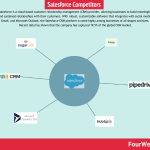
Salesforce is a cloud-based customer relationship management (CRM) provider, allowing businesses to build meaningful and sustained relationships with their customers. With robust, customizable software that integrates with social media, Gmail, and Microsoft Outlook, the Salesforce CRM platform is rated highly among businesses of all shapes and sizes. Recent data has shown that the company has captured 19.5% of the global CRM market.
Looking at Salesforce for multiple perspectivesNevertheless, the global reach of Salesforce means that it cannot serve the unique needs of every single client. Some may find the platform excessively complex or unwieldy, preferring a simple dashboard without the bells and whistles. Others may not have the budget to stick with Salesforce long term.
Microsoft Dynamics 365Microsoft Dynamics 365 is a similarly global system offered in 40 regions and 41 languages.
The Microsoft CRM is feature-rich but is relatively easy to use. Indeed, it can even run with an Outlook client to give the look and feel of a Microsoft Office environment. Users can maintain accounts, nurture sales leads, create sales collateral, and track contacts.
CRM software delivery can be achieved in several ways. It may be cloud-based, on-premise, or a combination of both and serves businesses of any size in any industry.
KeapKeap is regarded by many as the best CRM system in terms of ease of use, and for good reason. It features fully automated sales, marketing, and eCommerce packages with the option for clients to pay invoices through their preferred bank via instant message alerts.
Keap offers three tiered monthly subscription options, with each additional user incurring an additional fee. The Basic plan starts at $79, increasing to $149 for the Pro plan and $199 for the Enterprise plan.
Sugar SellSugar Sell is the name given to the sales automation software from Sugar CRM. It is a four-time winner of the PCMAG Business Choice Award for Customer Experience.
The platform gives employees the necessary data to optimize lead conversions and reach out to customers. It brings a plethora of features to the CRM space, including custom reporting, product cataloging, and custom quotes. There is also the option to make sales forecasts to improve predictability and visibility.
Sugar Sell is also available in app form for Android and iOS devices.
PipedrivePipedrive is particularly suited to businesses that find the onboarding process for new software daunting. It incorporates features such as email marketing, activities and goals management, and lead generation. It can also synthesize data into smaller, actionable reports.
Compared to Salesforce, Pipedrive is a much more affordable option with an intuitive design and importantly, 24/7 customer service.
HubSpot CRMHubSpot CRM is suited to self-employed individuals or sole traders. The company offers a feature-packed free version that is simple to use. Of course, individuals who wish to do so can upgrade to a more powerful paid system.
Regardless of which version is utilized, the HubSpot CRM can easily be synchronized to the rest of the HubSpot App Ecosystem.
Zoho CRMAmong CRM options for small businesses, Zoho CRM offers all of the most valuable CRM features at the best price. This makes it a significant force in the CRM market.
Importantly, Zoho has one of the largest integration fields of any provider. This makes it an ideal choice for smaller businesses that cannot afford fully customized software decks. The platform is also backed by extensive documentation to help customers navigate the sometimes difficult process of software upgrades.
Zoho CRM pricing is also versatile, offering five subscription plans. A free option is available for up to three users. Beyond that, businesses can select from a range of affordable plans offering a turn-key solution for tech novices.
Key takeaways:Salesforce has cornered almost 20% of the CRM market, but it is not a one-size-fits-all approach.Microsoft Dynamics 365 and HubSpot CRM are major Salesforce competitors because of their association with affiliated app ecosystems.Platforms such as Zoho CRM and Pipedrive also offer cheap, more automated options for the less tech-savvy.Read Also: Salesforce Business Model, Slack Business Model, C3.ai Business Model, SaaS Business Models, IaaS-PaaS-SaaS, AIaaS Business Model, Cloud Business Models.
Read Next: Competitor Analysis, Amazon Competitors, Tesla Competitors, Zoom Competitors, YouTube Competitors, Netflix Competitors.
Main Free Guides:
Business ModelsBusiness StrategyBusiness DevelopmentDigital Business ModelsDistribution ChannelsMarketing StrategyPlatform Business ModelsTech Business ModelWhat Is EntrepreneurshipThe post Salesforce Competitors appeared first on FourWeekMBA.
Shopify Competitors
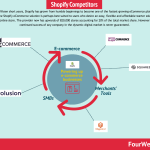
In just fifteen short years, Shopify has grown from humble beginnings to become one of the fastest-growing eCommerce platforms online. The Shopify eCommerce solution is perhaps best suited to users who desire an easy, flexible and affordable starter solution for their online store. The provider now has upwards of 820,000 stores accounting for 20% of the total market share. However, the continued success of any company in the dynamic digital market is never guaranteed.
WooCommerceThere is only one platform that is more popular than Shopify, and that is WooCommerce.
The platform is a best-seller primarily because it is based on the similarly popular WordPress content management system. Users who run WordPress can easily install the WooCommerce plugin for free. Happily, there are no transaction fees either.
A key difference between Shopify and WooCommerce is that the latter requires the user to be responsible for site hosting, PCI compliance, and security. This makes it more suited to those who are prepared to hire developers to build or maintain their store.
SquarespaceSquarespace is quite similar to Shopify in the sense that both offer a hosted solution that is accessible to all – regardless of technical skill level.
Indeed, the Squarespace interface is sleek and minimalist and features drag-and-drop sections to get the look that users desire.
Originally, Squarespace entered the market as a website builder for creatives and other small business owners. Many of these individuals have stuck with the company while it has added increased functionality to its content management system.
The company also employs an aggressive marketing strategy, partnering with influencers and Squarespace advocates to offer promotional discounts on its plans.
VolusionFounded in 1999, Volusion has enjoyed a long and successful presence in eCommerce as a leading solution for small and medium businesses.
Volusion cannot compete with Shopify for the number of installations, nor does it have as large a community. However, it is a robust hosted solution backed by regular maintenance and a widely-lauded customer support team. The company also guarantees that the check-out system is secure and safe.
The Volusion platform can also compete with Shopify on customization, offering a range of eye-catching themes to attract and convert customers.
BigCommerceAt the larger end of the market, BigCommerce is a significant Shopify competitor. It is a complete solution that is more feature-rich than the Shopify offering – especially where B2B eCommerce is concerned.
BigCommerce helps users build their store and get their products listed on popular networks such as Amazon, eBay, and Facebook. The company has also released a WordPress plugin, allowing merchants to sell their products with a focus on content. Importantly, this gives BigCommerce access to the highly popular WordPress CMS.
While it has not yet attained the popularity of Shopify or Shopify Plus, BigCommerce has grown rapidly in recent years and has attracted a significant amount of funding.
Magento 2Magento was the popular choice in eCommerce platforms before Shopify and BigCommerce even existed.
It is a cloud-based, open-source platform with an impressive list of capabilities. Magento is fully integrated with Adobe Experience Cloud, enabling simpler content creation and analytics management.
The company also caters to the needs of B2B eCommerce, incorporating features such as large order requisition lists, company account access sharing, quote requesting, and quick ordering.
A key strength of Magento 2 is that it is underpinned by a loyal and devoted following of developers. This makes it ideal for businesses who have unique or unusual content-driven commerce needs.
Key takeaways:Although Shopify enjoys significant market share, it is nonetheless part of a dynamic industry full of worthy and emerging competitors.Leveraging the immense popularity of WordPress, WooCommerce is the preferred interface of choice for store owners who want a reasonable level of control.BigCommerce is also a more feature-rich offering than Shopify that leverages the power of B2B commerce. In recent years it has been funded to grow rapidly.Read Also: Shopify Business Model, Subscription Business Models, E-Commerce Business Models.
Read Next: Competitor Analysis, Amazon Competitors, Tesla Competitors, Zoom Competitors, YouTube Competitors, Netflix Competitors.
Main Free Guides:
Business ModelsBusiness StrategyBusiness DevelopmentDigital Business ModelsDistribution ChannelsMarketing StrategyPlatform Business ModelsTech Business ModelWhat Is EntrepreneurshipThe post Shopify Competitors appeared first on FourWeekMBA.



